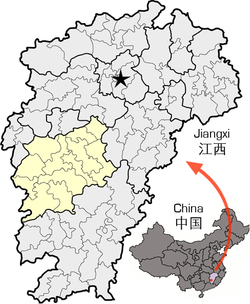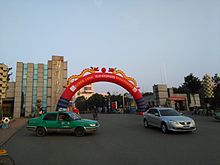
Back جيآن Arabic Gék-ăng CDO Ji'an (kapital sa prepektura sa Pangmasang Republika sa Tśina) CEB Ťi-an Czech Ji'an (Jiangxi) Danish Ji’an German Ĝian (Ĝjangŝjio) Esperanto Ji'an Spanish Ji'an Basque ژی ان Persian
Ji'an
吉安市 Kian | |
|---|---|
Top to bottom, left to right: Ji'an city hall, the Wugong Mountains on the border with Pingxiang, the Jinggang Mountains, Ji'an Revolutionary Museum, Qingyuan District Hall | |
 Location of Ji'an City jurisdiction in Jiangxi | |
| Coordinates (Ji'an municipal government): 27°05′28″N 114°58′01″E / 27.091243°N 114.96681°E | |
| Country | People's Republic of China |
| Province | Jiangxi |
| Government | |
| • CPC Secretary | Wang Ping (王萍) |
| • Mayor | Wang Shaoxuan (王少玄) |
| Area | |
| 25,283 km2 (9,762 sq mi) | |
| • Urban | 1,340 km2 (520 sq mi) |
| • Metro | 1,340 km2 (520 sq mi) |
| Elevation | 62 m (202 ft) |
| Population (2020 census)[1] | |
| 4,469,176 | |
| • Density | 180/km2 (460/sq mi) |
| • Urban | 643,399 |
| • Urban density | 480/km2 (1,200/sq mi) |
| • Metro | 643,399 |
| • Metro density | 480/km2 (1,200/sq mi) |
| GDP[2] | |
| • Prefecture-level city | CN¥ 132.3 billion US$ 21.3 billion |
| • Per capita | CN¥ 27,168 US$ 4,362 |
| Time zone | UTC+8 (China Standard) |
| Postal code | 343000 |
| Area code | 0796 |
| ISO 3166 code | CN-JX-08 |
| Licence plate prefixes | 赣D |
| Website | jian |

Ji'an (Chinese: 吉安; pinyin: Jí'ān) is a prefecture-level city situated in the central region of Jiangxi province of the People's Republic of China while bordering Hunan province to the west. It has an area of 25,219 km2 (9,737 sq mi) and as of the 2020 census, had a population of 4,469,176, of whom 643,399 live in the built-up (or metro) area made of 2 urban districts. Ji'an lies next to the Luoxiao Mountains (罗霄山脉) with the Gan River running through the middle of the city. Local dialects include a form of Gan Chinese (Jicha subgroup, 吉茶片) as well as Hakka Chinese.
Ji'an (吉安) is an abbreviation of its original name "吉泰民安" (pinyin: Jítài Mín'ān). It has also formerly been known as Luling (廬陵)[3] and Jizhou (吉州).
- ^ "China: Jiāngxī (Prefectures, Cities, Districts and Counties) - Population Statistics, Charts and Map".
- ^ 江西省统计局、国家统计局江西调查总队 (August 2016). 《江西统计年鉴-2016》. China Statistics Press. ISBN 978-7-5037-7809-4. Archived from the original on 2018-05-11. Retrieved 2017-06-05.
- ^ Gerritsen, Anne (2004). "From Demon to Deity: Kang Wang in Thirteenth-Century Jizhou and beyond (Du démon à la divinité: Kang Wang à Jizhou au XIIIe siècle et au-delà)" (PDF). T'oung Pao. 90 (1/3): 1–31. doi:10.1163/1568532042523158. JSTOR 4528955.




